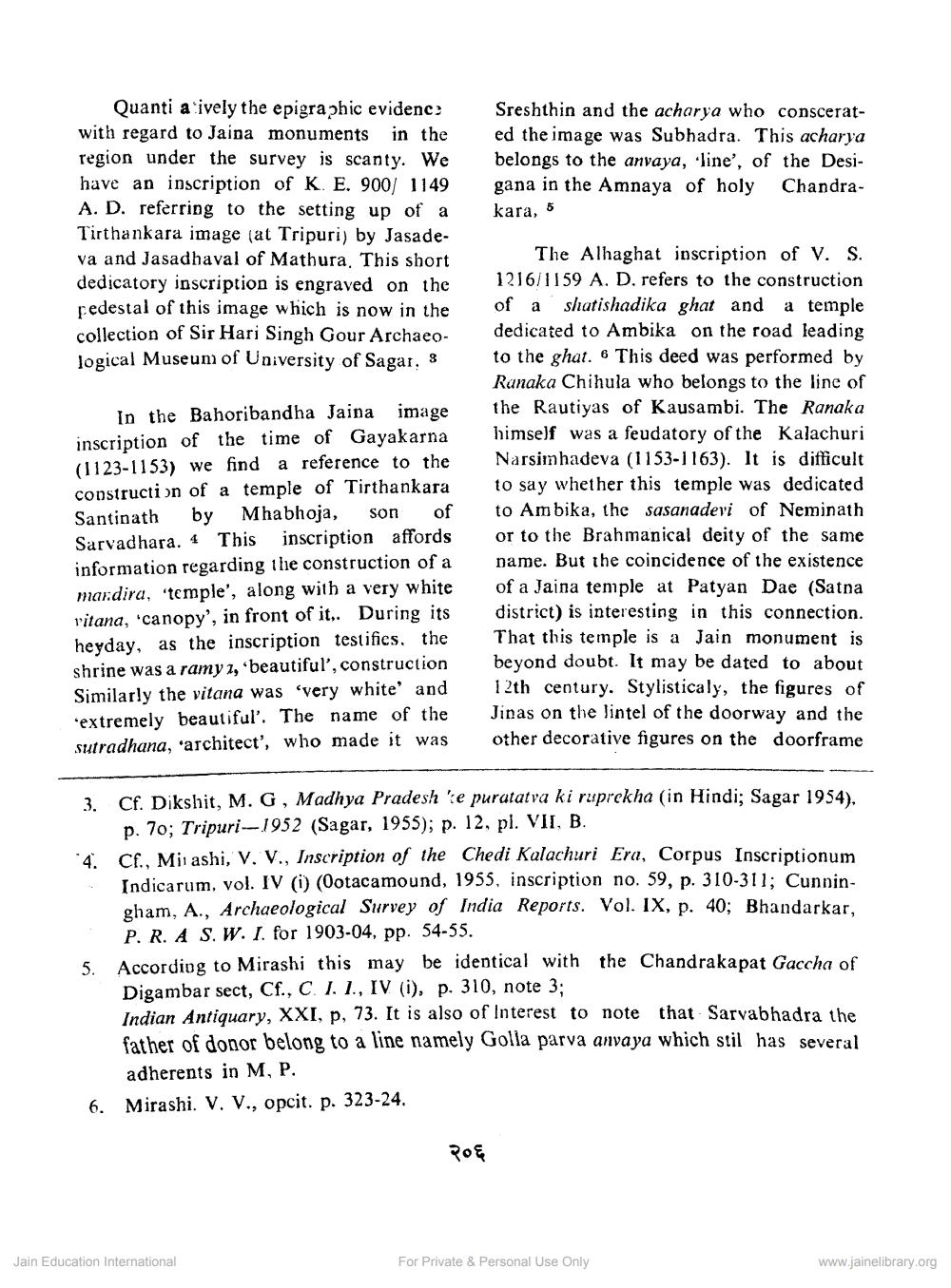________________
Quanti a ively the epigraphic evidenc: with regard to Jaina monuments in the region under the survey is scanty. We have an inscription of K. E. 900/ 1149 A. D. referring to the setting up of a Tirthankara image (at Tripuri) by Jasadeva and Jasadhaval of Mathura. This short dedicatory inscription is engraved on the pedestal of this image which is now in the collection of Sir Hari Singh Gour Archaeological Museum of University of Sagar. 3
In the Bahoribandha Jaina image inscription of the time of Gayakarna (1123-1153) we find a reference to the construction of a temple of Tirthankara Santinath by Mhabhoja, son of Sarvadhara. This inscription affords. information regarding the construction of a mandira, temple', along with a very white. ritana, canopy', in front of it.. During its heyday, as the inscription testifics. the shrine was a ramy 1, 'beautiful', construction Similarly the vitana was very white' and 'extremely beautiful'. The name of the sutradhana, architect', who made it was
Sreshthin and the acharya who conscerated the image was Subhadra. This acharya belongs to the anvaya, 'line', of the Desigana in the Amnaya of holy Chandrakara, 5
Jain Education International
The Alhaghat inscription of V. S. 1216/1159 A. D. refers to the construction of a shatishadika ghat and a temple dedicated to Ambika on the road leading to the ghat. This deed was performed by Ranaka Chihula who belongs to the line of the Rautiyas of Kausambi. The Ranaka himself was a feudatory of the Kalachuri Narsimhadeva (1153-1163). It is difficult to say whether this temple was dedicated to Ambika, the sasanadevi of Neminath or to the Brahmanical deity of the same name. But the coincidence of the existence of a Jaina temple at Patyan Dae (Satna) district) is interesting in this connection.. That this temple is a Jain monument is beyond doubt. It may be dated to about 12th century. Stylisticaly, the figures of Jinas on the lintel of the doorway and the other decorative figures on the doorframe.
3. Cf. Dikshit, M. G, Madhya Pradesh p. 70; Tripuri-1952 (Sagar, 1955); p. 4. Cf., Mi ashi, V. V., Inscription of the Chedi Kalachuri Era, Corpus Inscriptionum. Indicarum, vol. IV (i) (Ootacamound. 1955, inscription no. 59, p. 310-311; Cunningham, A., Archaeological Survey of India Reports. Vol. IX. p. 40; Bhandarkar, P. R. A S. W. I. for 1903-04, pp. 54-55.
e puratatva ki ruprekha (in Hindi; Sagar 1954). 12. pl. VII. B.
5. According to Mirashi this may be identical with the Chandrakapat Gaccha of Digambar sect, Cf., C. I. I, IV (i), p. 310, note 3;
Indian Antiquary, XXI. p. 73. It is also of Interest to note that Sarvabhadra the father of donor belong to a line namely Golla parva anvaya which stil has several adherents in M. P.
6. Mirashi. V. V., opcit. p. 323-24.
२०६
For Private & Personal Use Only
www.jainelibrary.org




